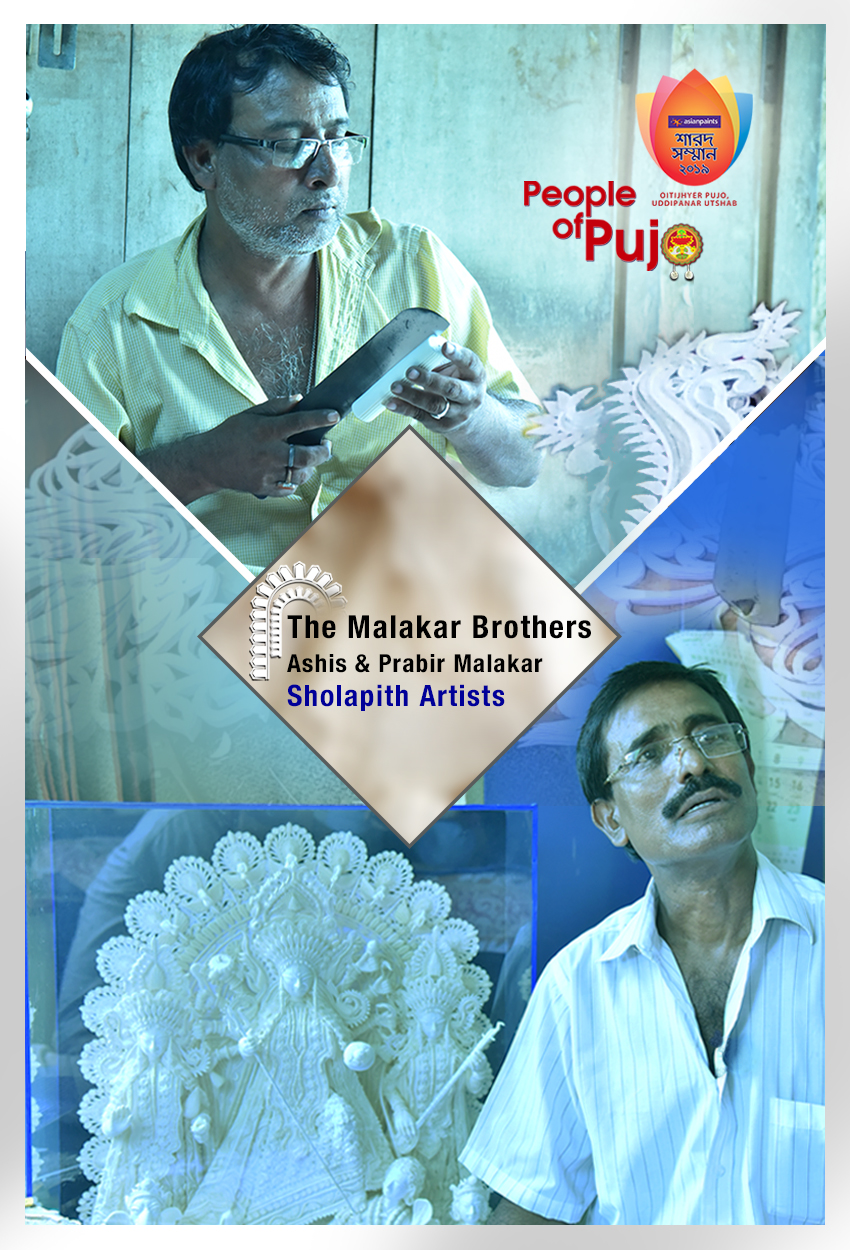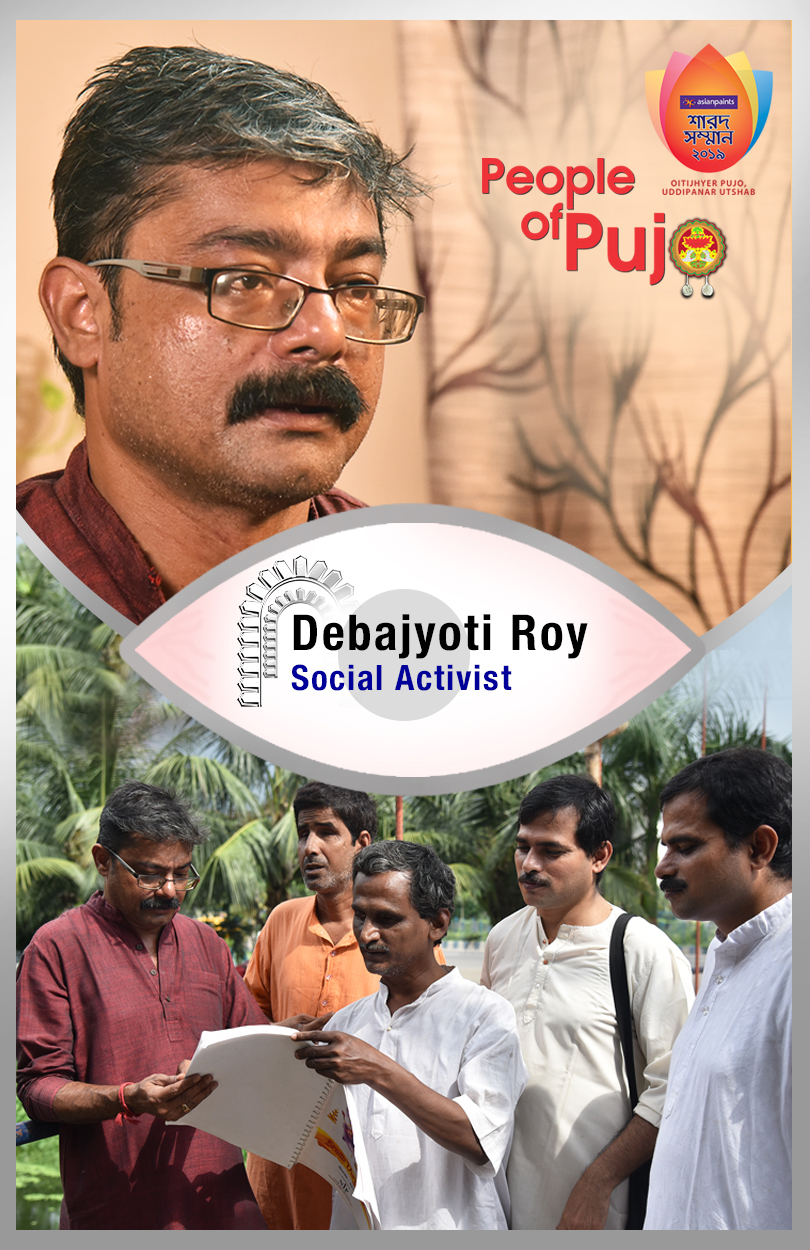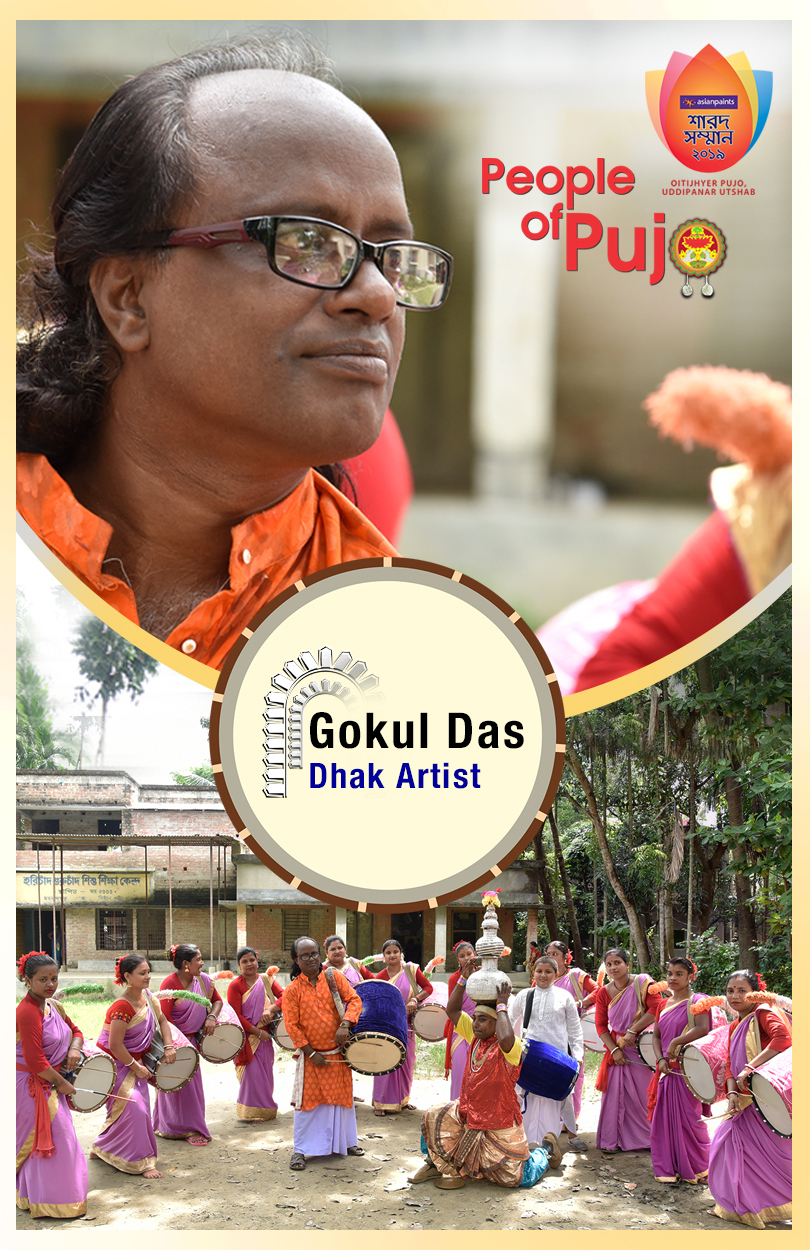Dugga Elo Ghawrey
The Malakar Brothers - Ashis Malakar & Prabir Malakar - The Sholapith Artists

During the time of World War II, when the perils of destruction was looming large, a new avatar of art was emerging here in the horizon of Kolkata Pujo. The war in Germany, incidentally opened ways for Shola art in Bengal’s Durga Pujo premise. The gilded foils and glass beads used in decorating the devi were sent by daak (post) from Europe and specifically from Germany. But once the war broke out, the stream of exports dwindled and the artisans here, in a frantic search to look for indigenous alternatives, turned to Shola, an aquatic wild herb grown in marshy wetlands. Sholapith then evolved as the medium for Durga’s décor. Mrityunjoy Malakar of Bankapasi pioneered in introducing ornate for Durga & Kali Pratimas made of Shola which even took Netaji Subhash Chandra Bose by surprise at that time. Bose went on to use ‘Shola r Saaj’ made by late Mrityunjoy for Kali Pujo at his residence.
Meet the Malakar brothers, the grandsons of Mrityunjoy, Ashis Malakar & Prabir Malakar from Bankapasi, a remote village of east Burdwan district. They belong to a family that proudly treasures three President’s Awards in their family chaste. After the demise of their grandfather, Katyayani Debi, their grandmother almost single handedly carried forward the legacy of the artistry along with managing the family. She bagged prestigious President’s award in 1979, though the 1st ever official honour to any Shola artist went to his son Aditya, in 1974.
Ashis Malakar, in his mid 50s today, received President’s Award in the year 1990 from the then President of India, Sri R. Venkataraman, for his exquisite work of a Durga Pratima craftly made with green ivory. His work took him across the globe from Singapore to Harare in Zimbabwe, from European countries to Caribbean Islands. In the year 2016, Ashis made an 18 feet Durga Pratima with Shola for a Pujo at Asansol that won him praises all over.
Prabir, the younger brother works at Ram Gopal Saha’s Pujo Bari in Bowbazar & Kali Pujo at Pathuriaghata every year after the demise of his legendary father. He also does quite a few Durga Pujo ornamentation works in New Delhi every year. Prabir and his team of 10 artisans start their Pujo centric work every year on the day of Rath Yatra.
Today, both Ashis & Prabir makes Shola models for exhibitions which take them to places for festivals across the globe. Their works are on permanent display at various premiere art museums in India & abroad but by heart they still get their joy out of making ornates for Durga Pratima. Shola is an organic substitute to thermocol but the Malakars are a little apprehensive about the supply of Shola in the days to come and inadequate rain this year has added to the woe.
We believe the intricate cuts & carves on the green ivories of Sholapith by the Malakar brothers shall surely lead this almost extinct art form to new heights once again.See less
Debajyoti Roy - Social Activist

“I strongly believe that the differently abled persons have inherent rights to their human dignity and irrespective of the origin, nature and seriousness of their handicaps and disabilities become as self-reliant as possible’’, says Debajyoti Roy, who runs an NGO called National Institute of Professionals (NIP). NIP initiated India’s first ever university directed computer course for the visually & physically challenged persons directed by Indira Gandhi National Open University (IGNOU) in 2004 & in the same year, two of their visual impaired students cleared the IGNOU exams with flying colours with all other general category students.
Debajyoti closely observed the kind of hurdles people with disabilities have to face every day in public transport. Many bus operators avoid entertaining such people, especially during the festive period due to heavy rush. “I was keen on changing this scenario. So, instead of a head on challenge, we opted to win them with love & humanity’’, commented Roy, who introduced a mass Rakhi bandhan campaign by the differently-abled people in the bus terminals of the city every year resulting in a gradual change in the behavioral pattern of bus drivers and conductors towards them.
Similarly, he was determined to make pandal hopping a hassle-free experience for the senior citizens & the differently abled people amidst the Pujo crowd. Debajyoti initiated a special award program for the pujo organisers back in 2010 rewarding pandals with easy access for differently abled & senior citizens. The Jury members comprised of differently abled and senior citizens. The City Pujo organizers also extended their cooperation to this movement & today most of the pandals have special arrangements ready for the ones who are in need of them.
In another path breaking move for the visually challenged society in Kolkata, Debajyoti & his NGO NIP launched a Pujo guide book in Braille which helped thousands of visually impaired people to reach out Pujo pandals independently. In a further move, in 2016, the theme of three hundred odd major Pujo pandals in Kolkata were added to this guide book. “Earlier we were dependant on the navigator who used to take us for pandal visits and the itinerary used be as per the liking or knowledge of that person. But now, with the introduction of Durga Pujo guide book in Braille, we can make our own logistic plans and can pick & choose the pandals as per the theme descriptions drafted here,’’ says a confident Sujit Karmakar, who is a successful musician and computer instructure.
This is what Debajyoti always wanted the differently abled people to be independent, self sufficient & earn their social rights. Durga Pujo is for all and the happiness quotient gets multiplied if it can be savoured by all. How badly we need more visionaries like Debajyoti Roy in our society to keep the happiness quotient flying for all! See less
Gokulchandra Das - Dhak Artist

It was during one of his concert tours with Ustad Zakir Hussain he came across a lady at a music store in Los Angeles demonstrating saxophone, clarinet, brass, trumpets to customers by playing them all by herself.” If a lady in US can do so to earn her bread why not our girls back in Bengal? In a way she was my inspiration to build up an all girl’s dhaki team starting with the women from my own family’’ says a smiling Gokul Chandra Das, the man who is the face of Bengal’s dhak in national & international stages today.
But it was not that easy for Gokul in those early days to make the girls play dhak in public forum. It was an uphill challenge to fight the social taboos & traditions prevailing in a small village of Maslandapur in 24 Parganas. Today Gokul’s women brigade has earned immense respect & reputation in the musical world, now they are a rage in Pujo circuit and even perform regularly in many a popular TV shows & corporate events , both his daughter & daughter-in law Uma & Sangeeta are pursuing their career as dhak players.
Rhythm runs in his family, Gokul himself is a third generation dhaki,his talents with the sticks was spotted by Pdt Tanmay Bose in a dhak competition in Pujo in 2004, since then Gokul became a permanent member in Bose’s musical troupe ‘Taaltantra’ and traveled the world with him. Today Gokul is almost an institution in grooming new dhakis, many of his team members & students are popular faces in Kolkata Pujo pandals. This year one of his teams would be performing in Tanzania during Pujo.
Gokul feels himself lucky to have shared stage with legends like Pdt Ravi Shankar, Ustaad Zakir Hussauin to contemporary musicians like Santanu Moitra. But his aim is to build an academy for young & budding dhakis where in the students can be given a degree or diploma post completion of the course. With such masters around, we can hear the beats of dhak playing loud in the future days as well.See less
Saju Talukdar - A Good Samaritan

As a little boy, sporting new clothes in Pujo was an unaffordable luxury for Saju Talukdar. His father, who was a tailor by profession, used to stitch shirts for him that was made out of leftover clothing materials of army men from nearby Hasimara Air base. This little boy is in mid forties today. He ensures that the poor and underprivileged people from the neighbouring villages in Dooars get garments round the year and more so during Durga Pujo. Saju Talukdar started a Clothes Bank with used garments in 2017. He collects used garments from people and distributes it amongst people who feel privileged to own even a used shirt or a saree.
Saju hails from Dimdima, the neighbouring terrain is dotted with lush green tea gardens but unfortunately many of them remain closed for larger part of the year resulting in acute miseries & lack of employment for many labourers. For thousands of such labourers who are mostly tribals, Saju is a demigod. He ensures that during this festive period they can at least have a garment to wear, even if it is a pre-worn one.
Today, Saju maintains a proper warehouse at NH 31, Dimdima More, to store the collected used garments from people and every week he reaches out to labour lines in tea gardens to distribute the same on his two wheelers & at time hires pick up vans. Saju has adopted a village at Carron Tea gardens, Nagrakata, where he provides the villagers their yearlong clothing and new garments before Pujo.
‘’Pujo is our greatest festival and we ensure our loved one get new clothes in Pujo every year. But there are plenty of them for whom just a piece of garment in Pujo mean a lot and if we can stand by them, I believe, our joy of Pujo will also multiply’’, Saju was murmuring standing before his ‘Heaven Shelter Home’ a camp where he has given shelter to some twenty destitute people and takes utmost care of them. Even today Saju makes it a point to wear only used garments collected from others. World is still such a wonderful place to live, only because of such great souls, our salute to the cloth banker! See less
Suparna Kanti Ghosh - Music Composer

Did you know that two of Bengali music’s all time cult songs were composed on the go? Yes, one in a double decker 2B bus en route to Hazra from Manna Dey’s residence at Hedua & the last part of another historic number was composed in an upper bunk of a sleeper class compartment in Howrah-Mumbai Mail via Nagpur.
Seventies is labeled as the golden era of Bengali music, with stalwart music directors like Hemanta Mukhopadhyay, Nachiketa Ghosh, Sudhin Dasgupta, Salil Chaudhury & RD Burman composing classic numbers one after another in their Pujo albums. That was the time when a young lad, barely a teenager then, dared to compose a Pujo release song for legendary Manna Dey in 1978. Many senior artists of that time had their strong reservations, but his ‘Manna Kaku’ chose his composition over some senior music directors. ‘’Se amar choto bon’’ was an instant hit after its release. ‘’I was thrilled to hear the song playing in the Biswakarma Pujo pandals that time and by the time Pujo came the song became a rage’’, recalls Suparna Kanti Ghosh, now in his early sixties today. That very year Suparna Kanti's another composition for Bhupen Hazarika, ’O malik.... megh kore dao’ also became a big hit in Pujo.
Came 1983, by that time Suparna Kanti, son of the legendary music composer late Nachiketa Ghosh, was preparing for his M.Com exams. In an informal session with lyricist Gouriprasanna Majumdar, he requested Gouriprasanna to pen lyrics on Bengali's very own adda. The master lyricist came up with the immortal lines ‘’Coffee houser sei adda ta’’ and the young composer started planting melody to the words. The concluding part was done in Mumbai Mail, on the way to the HMV recording studio in Mumbai. ‘’Famous guitarist of RD Burman's core team,Tony Vas played the bass guitar under the music arrangement of Y S Mulki with Manna Dey in the recording’’, recalls Suparna Kanti. 'Coffee house' was a super sensation with its release in Pujo that year & the rest is history.
'Coffee houser adda' has become an anthem for the Bengalis across the globe over the years. Ever since 1983 till his last concert, ‘’Coffee house’’ has been a mandatory song for Manna Dey in all his concerts. With time 'Coffee house' evolved as an epitome of ‘bengali nostalgia’. Today Suparna Kanti can afford to say ‘’Coffee house is no more my song, it has now become a public property of all the Bengalis across the world’’ and we just can’t agree more with him. See less
